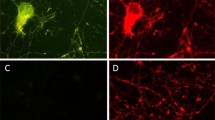Abstract
The possibility of long-term changes in the innate characteristics of the behaviour of mice of different genotypes (C57Bl/6 and BALB/c) after active immunization with dopamine-BSA conjugates was studied. These experiments revealed significant differences in the effects of anti-dopamine antibody on behavioral responses in an open field and neurotransmitter contents of brain structures in mice of different lines. Immunization with the dopamine-protein conjugate led to increases in the functional activity of the corresponding brain receptors, to different extents in mice of different lines.
Similar content being viewed by others
REFERENCES
L. A. Basharova, V. A. Evseev, L. A. Vetrilé, et al., “Induction of autoantibodies to serotonin and catecholamines with chronically morphine-treated rats with withdrawal syndrome,” Byull. Éksperim. Biol. Med., 115, No. 5, 469 (1993).
V. A. Evseev, L. A. Basharova, L. A. Vetrilé, et al., “Comparative analysis of the effects of systemic and intraventricular antibodies to serotonin on behavioral reactions and nociceptive sensitivity in animals,” Zh. Vyssh. Nerv. Deyat., 46, No. 1, 129 (1996).
V. A. Evseev, N. A. Trekova, L. A. Vetrilé, et al., “The neuromodulatory effects of antibodies to serotonin on behavioral reactions, CNS neurotransmitter levels, and the ligand-binding activity central serotonin receptors in C57Bl/6 and BALB/c mice,” Byull. Éksperim. Biol. Med., 132, No. 7, 26 (2001).
S. V. Zaitsev, M. G. Sergeeva, and S. D. Varfolomeev, “Radioreceptor analysis: theoretical bases of the method,” Bioorg. Khim., No. 3, 370 (1985).
N. A. Krupina, E. V. Popkova, I. N. Orlova, et al., “The effects of active immunization with a conjugate of dopamine and bovine serum albumin on the development of experimental MPTP-induced depressive syndrome and monoamine metabolism in the rat brain,” Zh. Vyssh. Nerv. Deyat., 50, No. 2, 287 (2000).
O. I. Mikovskaya, L. A Vetrilé, N. A. Trekova, et al., “Modulation by antibodies to serotonin of the behavioral responses of mice of different genotypes,” Zh. Vyssh. Nerv. Deyat., 51, No. 2, 190 (2001).
Yu. V. Skrinskaya and É. M. Nikulina, “Genotypic differences in brain dopamine metabolism and dopamine-dependent forms of behavior in mice,” Genetika, 24, No. 7, 1321 (1988).
Yu. V. Skrinskaya and É. M. Nikulina, “Effects of stimulation of dopamine receptors on motor and stereotypic activity of mice of different genotypes,” Zh. Vyssh. Nerv. Deyat., 42, No. 3, 549 (1992).
N. A. Trekova, L. A. Basharova, L. A. Vetrilé, et al., “Effects of antibodies to serotonin on a conditioned passive avoidance response in rats,” Zh. Vyssh. Nerv. Deyat., 45, No. 3, 596 (1995).
N. A. Trekova, L. A. Vetrilé, L. A. Bahsarova, et al., “Antibodies to dopamine: effects on behavior in an open field, pain sensitivity, CNS monoamine contents, and the functional activity of immunocytes in C57Bl/6 mice,” Zh. Vyssh. Nerv. Deyat., 49, No. 5, 799 (1999).
N. A. Trekova, T. G. Khlopushina, L. A. Basharova, et al., “Effects of antibodies to serotonin on the behavior of C57Bl/6 mice in an open field and monoamine contents in brain structures,” Zh. Vyssh. Nerv. Deyat., 48, No. 2, 251 (1998).
A. Yu. Shemanov, I. L. Miroshnichenko, V. S. Kudrin, et al., “Effects of L-3,4-dihydroxyphenylalanine on tyrosine hydroxylation and the levels of biogenic amines and their metabolites in synaptosomes from the striate body of the rat,” Neirokhimiya, 7, No. 3, 323 (1988).
A. Y. Dunn, K. L. Elfvin, and C. W. Berridge, “Changes in plasma corticosterone and cerebral biogenic amines and their metabolites during training and testing of mice in passive avoidance behaviour,” Behav. Neural. Biol., 46, No. 3, 410 (1996).
A. Mendlin, F. S. Marten, and B. L. Jacobs, “Dopaminergic input is required for increases in serotonin output produced by behavioral activation: an in vivo microdialysis study,” Neurosci., 93, 897 (1999).
D. B. Schafer, “Measurement of receptor-ligand binding: theory and practice,” Lect. Notes. Biomatch., 48, 445 (1983).
L. Ugedo, J. Grenhoff, and T. H. Hevensson, “Ritanserin, a 5-HT2 receptor antagonist, activates midbrain dopamine neurons by blocking serotonin inhibition,” Psychopharmacology, 98, 45 (1989).
P. C. Waldmeir and A. A. Delini-Stula, “Serotonin-dopamine interactions in nigrostriatal system,” Eur. J. Pharmacol., 55, 363 (1979).
Author information
Authors and Affiliations
Rights and permissions
About this article
Cite this article
Evseev, V.A., Mikovskaya, O.I., Vetrilé, L.A. et al. Antibodies to Dopamine as Neuromodulators of Behavioral Responses of Mice of Different Genotypes. Neurosci Behav Physiol 33, 507–512 (2003). https://doi.org/10.1023/A:1023471402939
Issue Date:
DOI: https://doi.org/10.1023/A:1023471402939



